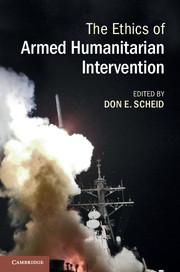
- Publisher:
- Cambridge University Press
- Online publication date:
- June 2014
- Print publication year:
- 2014
- Online ISBN:
- 9781139567589


The question of military intervention for humanitarian purposes is a major focus for international law, the United Nations, regional organizations such as NATO, and the foreign policies of nations. Against this background, the 2011 bombing in Libya by Western nations has occasioned renewed interest and concern about armed humanitarian intervention (AHI) and the doctrine of Responsibility to Protect (RtoP). This volume brings together new essays by leading international, philosophical, and political thinkers on the moral and legal issues involved in AHI, and contains both critical and positive views of AHI. Topics include the problem of abuse and needed limitations, the future viability of RtoP and some of its problematic implications, the possibility of AHI providing space for peaceful political protest, and how AHI might be integrated with post-war justice. It is an important collection for those studying political philosophy, international relations, and humanitarian law.
‘… a useful collection of insightful perspectives and important contributions to AHI debates.’
Amanda Cawston Source: The Philosophical Quarterly
 Loading metrics...
Loading metrics...
* Views captured on Cambridge Core between #date#. This data will be updated every 24 hours.
Usage data cannot currently be displayed.